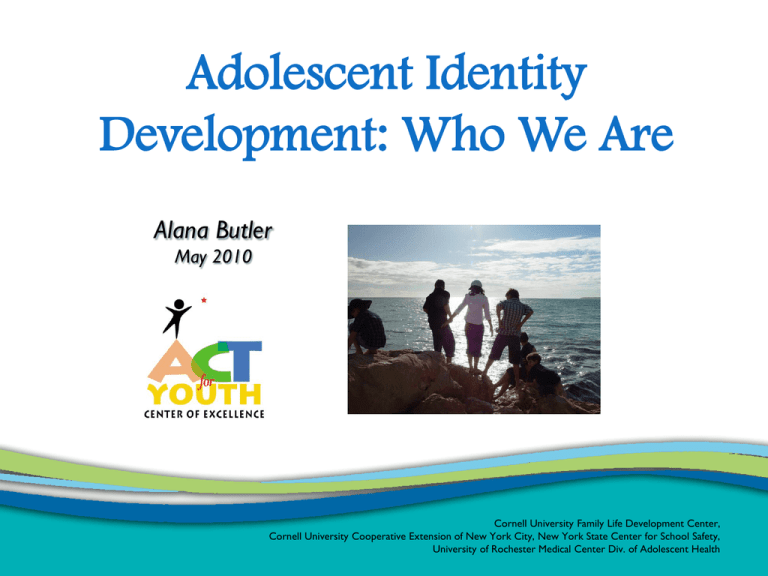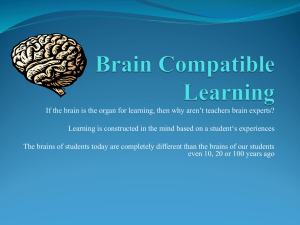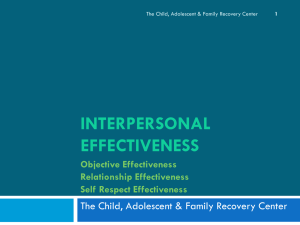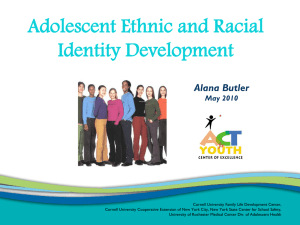Adolescent Identity Development
advertisement

Adolescent Identity Development: Who We Are Alana Butler May 2010 Cornell University Family Life Development Center, Cornell University Cooperative Extension of New York City, New York State Center for School Safety, University of Rochester Medical Center Div. of Adolescent Health Learning Objectives In this presentation, you will learn how to: Define identity. Distinguish between self-identity and social-identity. Identify the tasks and “statuses” of adolescent identity development. Recognize the importance of identity development for youth. Adolescent Identity Development Alana Butler • May 2010 What is Identity? Our sense of who we are. Sense of belonging to a social category. Dynamic, complex; changes over time. Adolescent Identity Development Alana Butler • May 2010 Self-Identity vs. Social Identity Self-identity is how you see yourself. Social identity is how others see you. Adolescent Identity Development Alana Butler • May 2010 Each of us has multiple identities that may be more or less important depending on the context we find ourselves in. Gender identity Religious identity Racial identity Ethnic identity National identity Generational identity Sexual identity Political identity Regional identity Professional identity Cultural identity Class identity Adolescent Identity Development Alana Butler • May 2010 Our Multiple Identities Jasneet: Celebrates the Indian festival of Diwali with her extended family. Celebrates American holidays with her peers from high school. Adolescent Identity Development Alana Butler • May 2010 Which identities did you juggle as you grew up? A) Gender identity B) Sexual identity C) Religious identity D) Racial identity E) Ethnic identity F) National identity G) Generational identity Submit Clear Erikson’s Theory of Psychosocial Development Psychosocial development proceeds in 8 stages, called crises. Adolescents experience the fifth stage, called Identity vs. Identity Diffusion. Adolescent Identity Development Alana Butler • May 2010 Erikson Identity vs. Identity Diffusion An adolescent in this stage may achieve a secure identity or identity diffusion, which is an insecure sense of self. The key to resolving identity vs. identity diffusion lies in the adolescent’s interaction with others. Adolescent Identity Development Alana Butler • May 2010 According to Erikson, adolescents typically experience the fifth stage, identity vs. identity diffusion, between which ages? A) 10-13 B) 12-16 C) 12-18 D) 10-20 The answer is C) 12-18. Click anywhere to continue Correct - Click anywhere to continue Submit Clear Marcia’s Identity Development Status Identified four “identity statuses.” These statuses occur anytime during adolescence. Adolescent Identity Development Alana Butler • May 2010 Marcia Status 1: Identity Diffusion Identity Diffusion: low commitment to a particular identity. We may not think about a particular identity until we experience a crisis or are otherwise compelled to adopt an identity. Adolescent Identity Development Alana Butler • May 2010 Scenario: Identity Diffusion Jason Graduating in the following semester. Has not thought about what he wants to do after graduation and has not explored college or job prospects. Adolescent Identity Development Alana Butler • May 2010 Marcia Status 2: Identity Foreclosure A commitment to an identity without a crisis. Adolescent Identity Development Alana Butler • May 2010 Scenario: Identity Foreclosure Jennifer Passionate about music. Parents expect her to follow in their footsteps. Enters pre-med college program. Abandons musical interests. Adolescent Identity Development Alana Butler • May 2010 Marcia Status 3: Identity Moratorium In the midst of a crisis, searching for an identity to adopt. Can create conflict between adolescents and their authority figures. Adolescent Identity Development Alana Butler • May 2010 Scenario: Identity Moratorium Samantha Raised Catholic Reading about other religions Attended a Buddhist temple and has also attended a synagogue. Unsure which religion, if any, she wants to follow. Adolescent Identity Development Alana Butler • May 2010 Marcia Status 4: Identity Achievement Identity is said to be achieved when the adolescent has undergone a crisis (exploration) and now made a commitment to a particular identity. Adolescent Identity Development Alana Butler • May 2010 Scenario: Identity Achievement Richard Reads about vegan diets Consults nutritionist Become vegan; has been a vegan for three years and is secure in his identity. Adolescent Identity Development Alana Butler • May 2010 Identity and Self-Esteem A positive self-identity is connected to positive self-esteem! Having a social identity that is devalued will affect overall self-esteem Reinforcing positive social identity development is very important. Adolescent Identity Development Alana Butler • May 2010 Our Identities: In Conclusion Self-identities and social-identities may not only be different but may also confer privilege. Statuses in adolescent identity development change over time. Our many identities may intersect and cannot be separated from each other in our minds. Identity is a very important aspect for our self-esteem. Adolescent Identity Development Alana Butler • May 2010 Was this presentation useful? Please give us your feedback: http://www.zoomerang.com/Survey/WEB22AEZWMYJH3 The ACT for Youth Center of Excellence connects positive youth development resources and research to practice in New York State and beyond. The Center provides: Technical support, training, and evaluation for youth-serving programs funded by the NYS Department of Health. Youth Development resources: www.actforyouth.net, publications, training and events, and the e-letter ACT for Youth Update. Email act4youth@cornell.edu to subscribe. A home base for the ACT Youth Network. Visit the network at www.nysyouth.net ACT for Youth Center of Excellence act4youth@cornell.edu • 607-255-7736 • http://www.actforyouth.net Web Resources Child Development Institute: Stages of Social-Emotional Development In Children and Teenagers http://www.childdevelopmentinfo.com/development/erickson.shtml Identity Formation Wiki http://psychology.wikia.com/wiki/Identity_formation Identity Crisis - Theory and Research http://psychology.about.com/od/theoriesofpersonality/a/identitycrisis.htm Ethics of Identity http://www.philosophytalk.org/pastShows/EthicsofIdentity.htm Social Psychology Compass: Articles related to Identity in database http://www.blackwell-compass.com/subject/socialpsychology/ General Psychology Resources http://www.thepsychfiles.com/ Adolescent Identity Development Alana Butler • May 2010 Resources: Books Abrams, D., & Hogg, M. A. (1999). Social identity theory and social cognition. Oxford: Blackwell. Blackman, S. J. (1995).Youth--positions and oppositions. Style, sexuality, and schooling. Aldershot , Brookfield, VT: Avebury. Cieslik, M., & Pollock, G. (Eds.). (2002). Young people in risk society. The restructuring of youth identities and transitions in late modernity. Burlington,VT: Ashgate. Cornbleth, C. (2003). Hearing America's youth. Social identities in uncertain times. New York: Peter Lang. Epstein, J. S. (Ed.). (1998).Youth culture: Identity in a postmodern world. Oxford: Blackwell. Muñoz, C. (1989).Youth, identity, power. The Chicano movement. New York: Verso. Roche, J., & Tucker, S. (Eds.). (1997). Youth in society: Contemporary theory, policy and practice. London: Sage. Savin-Williams, R. C. (1990). Gay and lesbian youth. Expressions of identity. New York: Hemisphere. Weis, L., & Fine, M. (2000). Construction sites. Excavating race, class, and gender among urban youth. New York: Teachers College Press. Adolescent Identity Development Alana Butler • May 2010








